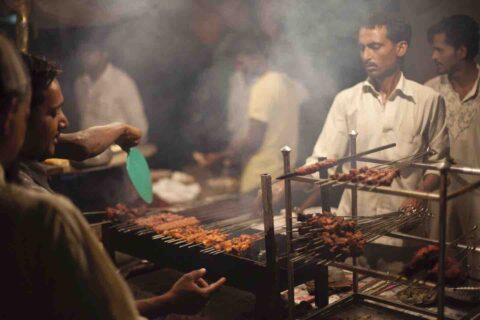News
Could Genetically Engineered Fungus Help Replace Animal Protein?
Breakthroughs•5 min read
Reported
Since 2006, Indians have witnessed a major shift in the national diet: from vegetarian to one that contains more meat. But as diets continue to change, so will the climate.


Words by Kritika Singh
Today, about one billion Indians follow Hinduism, and many Hindus avoid eating meat to minimize harming animals. As a result, India is often misperceived as a majority vegetarian nation. But according to the International Institute of Population Sciences, in 2017, nearly 70 percent of Indians consumed meat at least occasionally.
The consumption patterns in India are mostly driven by socio-economic conditions and religious beliefs. According to a recent study, while meat consumption is on the rise in the country, there are social stigmas attached to it. These social stigmas have thereby given rise to discrepancies in meat consumption patterns in public and private spaces.
The study points out how private meat consumption in India happens in a variety of different ways. Places outside the home like restaurants, food courts, offices, or segregated ‘safe’ spaces like lawns, separate kitchens, and dining spaces for non-vegetarian family members at home are backstage settings for eating meat in India.
However, getting an accurate estimate of meat consumption in India is a struggle. Various research notes that Indians are particularly likely to underreport their consumption of meat due to cultural restrictions and taboos associated with eating it.
Among the various meats consumed in India, chicken and fish have the highest consumption rate per capita, according to a National Sample Survey conducted in 2012. According to the study done by Preeti Dhillon, a researcher at the International Institute for Population Sciences in Mumbai, a non-vegetarian diet, especially fish and other seafood, is most common in the coastal regions in India.
The popularity of chicken in the country is relatively high due to its versatility. Chicken is also not associated with religious taboos. But while India is considered one of the world’s fastest-growing poultry markets, The Hindu reports that the consumption of beef and buffalo meat is on the rise.
According to India’s 2014 census, only three in ten Indians self-identify as vegetarian. Even among Indian vegetarians, it is estimated that three-quarters are Lacto-vegetarians (i.e., milk and dairy products are consumed but not meat or eggs) and about a quarter of Indian vegetarians are lacto-ovo-vegetarians (i.e., eggs and dairy products are consumed but not meat).
Could this mean that India is ready for alt-meat? A recent study assessed consumer preferences in Mumbai for four sources of protein: conventional meat, plant-based meat, cell-based meat, and chickpeas. While participants consistently rated plant-based meats higher than cell-based or conventional meat, it is important to note that the same might not be true in tier two or three cities where meat is still considered a luxury item associated with rising social status. There, people aren’t looking at plant-based alternatives, at least not yet.
The study also found that the target market for meat alternatives in India is often made up of health-conscious individuals and not vegans or vegetarians. This helps explain the discrepancy between public and private meat consumption in India.
Since 2006, India has witnessed a major shift from vegetarian diets toward diets containing larger amounts of meat. Factors like urbanization, greater exposure to newer cultures, and increasing disposable incomes could be possible reasons for the shift.
Although India’s per-capita meat consumption is low, according to research collected by data scientists Hannah Ritchie and Max Roser in 2019, India’s total meat consumption and total livestock counts are some of the highest globally.
According to the Department of Animal Husbandry, there are 2.3 billion broiler chickens, 135 million goats and sheep, and 3.3 million cattle slaughtered for their meat every year in India alone. Illegal licensing of slaughterhouses and corruption paves the way for less conventional methods of meat production, such as the dog meat trade. Before the recent ban on dog meat sold in the state of Nagaland, there were approximately 30,000 dogs slaughtered annually.
In 2012, India’s annual GHG emissions were equivalent to 18 percent of gross national emissions. Livestock represented more than half of those emissions. In 2017, the agriculture sector contributed to 19.6 percent of India’s total GHG emissions, with livestock products like mutton (goat meat), eggs, milk, and poultry representing over 70 percent of those emissions.
Some researchers have projected that higher consumption of animal-based products is the primary driver of India’s increasing GHG emissions, worsening water scarcity, and intensifying land use. With a population of 1.3 billion (That’s four times the population of the U.S. living on one-third of the landmass.), India’s existing and future meat consumption patterns will have a serious global impact.
There’s very little to no research done on the impact that growing demand for animal-based food in developing countries like India can have on the global environmental structure. With a number of diseases on the rise, what does India’s rising meat consumption mean for future generations, and what impact will it have on public health, the planet, and the animals? Only time will tell.